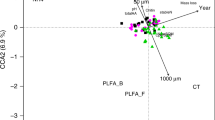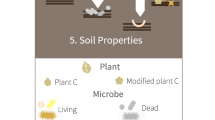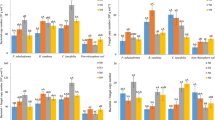Abstract
The amount and composition of root exudates—low-molecular-weight carbon compounds released from living plant roots into soil—are expected to shift under global change, and a growing body of work indicates that root exudates have important impacts on stable soil organic matter dynamics. However, most research on exudate effects on soil organic matter uses highly homogenized or artificial soil, leaving major uncertainties in how exudates will influence carbon dynamics in natural, intact soil systems. We used 13C-labelled artificial root exudates to examine the effects of exudation rate and type on stable soil organic matter formation and loss in intact forest soil cores collected over a heterogeneous gradient in a temperate hardwood forest. We observed effects of different exudate treatments on stable soil carbon dynamics that overrode native soil heterogeneity, and higher exudation rates enhanced mineral-associated organic matter turnover but not accumulation. Organic and amino acid exudates led to net mineral-associated organic matter accumulation, with amino acids having particularly strong positive effects on microbial biomass. Simple sugars increased mineral-associated organic matter turnover (both formation and loss) but did not alter the size of this pool. Our results suggest that predicted increases in root exudation rates and compositional shifts towards simple sugars under global change may reduce soils’ C storage capacity.
This is a preview of subscription content, access via your institution
Access options
Access Nature and 54 other Nature Portfolio journals
Get Nature+, our best-value online-access subscription
$29.99 / 30 days
cancel any time
Subscribe to this journal
Receive 12 print issues and online access
$259.00 per year
only $21.58 per issue
Buy this article
- Purchase on Springer Link
- Instant access to full article PDF
Prices may be subject to local taxes which are calculated during checkout




Similar content being viewed by others
Data availability
Data underlying this study can be found at https://doi.org/10.6084/m9.figshare.21221288 and metadata at https://doi.org/10.6084/m9.figshare.21221294.
Code availability
Code for statistics and figure generation can be found at https://doi.org/10.6084/m9.figshare.21221300.
References
Keenan, T. F. & Williams, C. A. The terrestrial carbon sink. Annu. Rev. Environ. Resour. 43, 219–243 (2018).
Terrer, C. et al. A trade-off between plant and soil carbon storage under elevated CO2. Nature 591, 599–603 (2021).
Walker, A. P. et al. Integrating the evidence for a terrestrial carbon sink caused by increasing atmospheric CO2. N. Phytol. 229, 2413–2445 (2021).
Fossum, C. et al. Belowground allocation and dynamics of recently fixed plant carbon in a California annual grassland. Soil Biol. Biochem. 165, 108519 (2022).
Rasse, D. P., Rumpel, C. & Dignac, M.-F. Is soil carbon mostly root carbon? Mechanisms for a specific stabilisation. Plant Soil 269, 341–356 (2005).
Sokol, N. W., Kuebbing, Sara, E., Karlsen-Ayala, E. & Bradford, M. A. Evidence for the primacy of living root inputs, not root or shoot litter, in forming soil organic carbon. N. Phytol. 221, 233–246 (2019).
Calvo, O. C., Franzaring, J., Schmid, I. & Fangmeier, A. Root exudation of carbohydrates and cations from barley in response to drought and elevated CO2. Plant Soil 438, 127–142 (2019).
Fransson, P. M. A. & Johansson, E. M. Elevated CO2 and nitrogen influence exudation of soluble organic compounds by ectomycorrhizal root systems. FEMS Microbiol. Ecol. 71, 186–196 (2009).
Johansson, E. M., Fransson, P. M. A., Finlay, R. D. & van Hees, P. A. W. Quantitative analysis of soluble exudates produced by ectomycorrhizal roots as a response to ambient and elevated CO2. Soil Biol. Biochem. 41, 1111–1116 (2009).
Phillips, R. P., Finzi, A. C. & Bernhardt, E. S. Enhanced root exudation induces microbial feedbacks to N cycling in a pine forest under long-term CO2 fumigation. Ecol. Lett. 14, 187–194 (2011).
Jilling, A., Keiluweit, M., Gutknecht, J. L. M. & Grandy, A. S. Priming mechanisms providing plants and microbes access to mineral-associated organic matter. Soil Biol. Biochem. 158, 108265 (2021).
Cotrufo, M. F., Wallenstein, M. D., Boot, C. M., Denef, K. & Paul, E. The Microbial Efficiency-Matrix Stabilization (MEMS) framework integrates plant litter decomposition with soil organic matter stabilization: do labile plant inputs form stable soil organic matter? Glob. Change Biol. 19, 988–995 (2013).
Sokol, N. W., Sanderman, J. & Bradford, M. A. Pathways of mineral-associated soil organic matter formation: integrating the role of plant carbon source, chemistry, and point of entry. Glob. Change Biol. 25, 12–24 (2019).
Bradford, M. A., Keiser, A. D., Davies, C. A., Mersmann, C. A. & Strickland, M. S. Empirical evidence that soil carbon formation from plant inputs is positively related to microbial growth. Biogeochemistry 113, 271–281 (2013).
Keiluweit, M. et al. Mineral protection of soil carbon counteracted by root exudates. Nat. Clim. Change 5, 588–595 (2015).
Kuzyakov, Y., Friedel, J. K. & Stahr, K. Review of mechanisms and quantification of priming effects. Soil Biol. Biochem. 32, 1485–1498 (2000).
Jones, D. L., Dennis, P. G., Owen, A. G. & van Hees, P. A. W. Organic acid behavior in soils—misconceptions and knowledge gaps. Plant Soil 248, 31–41 (2003).
Cleveland, C. C. & Liptzin, D. C:N:P stoichiometry in soil: is there a “Redfield ratio” for the microbial biomass? Biogeochemistry 85, 235–252 (2007).
Meier, I. C., Finzi, A. C. & Phillips, R. P. Root exudates increase N availability by stimulating microbial turnover of fast-cycling N pools. Soil Biol. Biochem. 106, 119–128 (2017).
Canarini, A., Kaiser, C., Merchant, A., Richter, A. & Wanek, W. Root exudation of primary metabolites: mechanisms and their roles in plant responses to environmental stimuli. Front. Plant Sci. 10, 157 (2019).
Koo, B.-J., Adriano, D. C., Bolan, N. S. & Barton, C. D. in Encyclopedia of Soils in the Environment (ed. Hillel, D.) 421–428 (Elsevier, 2005); https://doi.org/10.1016/B0-12-348530-4/00461-6
Oldfield, E. E., Crowther, T. W. & Bradford, M. A. Substrate identity and amount overwhelm temperature effects on soil carbon formation. Soil Biol. Biochem. 124, 218–226 (2018).
Mason-Jones, K., Schmücker, N. & Kuzyakov, Y. Contrasting effects of organic and mineral nitrogen challenge the N-mining hypothesis for soil organic matter priming. Soil Biol. Biochem. 124, 38–46 (2018).
Sokol, N. W. & Bradford, M. A. Microbial formation of stable soil carbon is more efficient from belowground than aboveground input. Nat. Geosci. 12, 46–53 (2019).
Drake, J. E. et al. Stoichiometry constrains microbial response to root exudation—insights from a model and a field experiment in a temperate forest. Biogeosciences 10, 821–838 (2013).
Falchini, L., Naumova, N., Kuikman, P. J., Bloem, J. & Nannipieri, P. CO2 evolution and denaturing gradient gel electrophoresis profiles of bacterial communities in soil following addition of low molecular weight substrates to simulate root exudation. Soil Biol. Biochem. 35, 775–782 (2003).
Rasmussen, C., Southard, R. J. & Horwath, W. R. Soil mineralogy affects conifer forest soil carbon source utilization and microbial priming. Soil Sci. Soc. Am. J. 71, 1141–1150 (2007).
Frey, S. D., Lee, J., Melillo, J. M. & Six, J. The temperature response of soil microbial efficiency and its feedback to climate. Nat. Clim. Change 3, 395–398 (2013).
Angst, G., Mueller, K. E., Nierop, K. G. J. & Simpson, M. J. Plant- or microbial-derived? A review on the molecular composition of stabilized soil organic matter. Soil Biol. Biochem. 156, 108189 (2021).
Craig, M. E. et al. Fast-decaying plant litter enhances soil carbon in temperate forests but not through microbial physiological traits. Nat. Commun. 13, 1229 (2022).
Blagodatsky, S., Blagodatskaya, E., Yuyukina, T. & Kuzyakov, Y. Model of apparent and real priming effects: linking microbial activity with soil organic matter decomposition. Soil Biol. Biochem. 42, 1275–1283 (2010).
Hill, P. W., Farrar, J. F. & Jones, D. L. Decoupling of microbial glucose uptake and mineralization in soil. Soil Biol. Biochem. 40, 616–624 (2008).
Asmar, F., Eiland, F. & Nielsen, N. E. Interrelationship between extracellular enzyme activity, ATP content, total counts of bacteria and CO2 evolution. Biol. Fertil. Soils 14, 288–292 (1992).
Fontaine, S., Mariotti, A. & Abbadie, L. The priming effect of organic matter: a question of microbial competition? Soil Biol. Biochem. 35, 837–843 (2003).
McFarlane, K. J. et al. Comparison of soil organic matter dynamics at five temperate deciduous forests with physical fractionation and radiocarbon measurements. Biogeochemistry 112, 457–476 (2013).
Post, W. M., Emanuel, W. R., Zinke, P. J. & Stangenberger, A. G. Soil carbon pools and world life zones. Nature 298, 156–159 (1982).
Smith, W. H. Character and significance of forest tree root exudates. Ecology 57, 324–331 (1976).
Dong, J. et al. Impacts of elevated CO2 on plant resistance to nutrient deficiency and toxic ions via root exudates: a review. Sci. Total Environ. 754, 142434 (2021).
White, M. A., Running, S. W. & Thornton, P. E. The impact of growing-season length variability on carbon assimilation and evapotranspiration over 88 years in the eastern US deciduous forest. Int. J. Biometeorol. 42, 139–145 (1999).
Giasson, M.-A. et al. Soil respiration in a northeastern US temperate forest: a 22-year synthesis. Ecosphere 4, 140 (2013).
Mrak, T. et al. Elevated ozone prevents acquisition of available nitrogen due to smaller root surface area in poplar. Plant Soil 450, 585–599 (2020).
Cotrufo, M. F., Ranalli, M. G., Haddix, M. L., Six, J. & Lugato, E. Soil carbon storage informed by particulate and mineral-associated organic matter. Nat. Geosci. 12, 989–994 (2019).
Brookes, P. C., Landman, A., Pruden, G. & Jenkinson, D. S. Chloroform fumigation and the release of soil nitrogen: a rapid direct extraction method to measure microbial biomass nitrogen in soil. Soil Biol. Biochem. 17, 837–842 (1985).
Haney, R. L., Franzluebbers, A. J., Hons, F. M. & Zuberer, D. A. Soil C extracted with water or K2SO4: pH effect on determination of microbial biomass. Can. J. Soil Sci. 79, 529–533 (1999).
Ahmed, M. J. & Hossan, J. Spectrophotometric determination of aluminium by morin. Talanta 42, 1135–1142 (1995).
Viollier, E., Inglett, P. W., Hunter, K., Roychoudhury, A. N. & Van Cappellen, P. The ferrozine method revisited: Fe(II)/Fe(III) determination in natural waters. Appl. Geochem. 15, 785–790 (2000).
Acknowledgements
We thank C. Berlingeri and A. Aguilar for help collecting and processing samples, S. Frey and M. Knorr for facilitating our work at the field site and C. Heslop for statistics advice. Thanks to A. Becker (B & B Fabrications) for the help on designing exudate delivery pumps and B. Erkkila (YASIC) for analytical advice. We also thank the Harvard Forest LTER and specifically A. Barker Plotkin and J. Thompson for their ongoing support with this project. N.R.C. was supported by the Harvard Forest LTER Graduate Student Research Award. The land Harvard Forest occupies is the unceded home territory of the Nipmuc People. Centuries of Indigenous stewardship and knowledge helped shape the ecosystems we study today, and we honour the vital role of Nipmuc community members in shaping these ecosystems into the future. This honouring is an active process that includes co-developing questions and knowledges, promoting Indigenous community self-determination and continuing to build a reciprocal relationship with the Nipmuc that ensures that this land and its life-giving benefits are mutually accessible, affirming and sustaining.
Author information
Authors and Affiliations
Contributions
N.R.C. and B.N.T. conceived and designed the project. N.R.C. conducted the experiments and analysed the data. N.R.C. and B.N.T. wrote the manuscript.
Corresponding authors
Ethics declarations
Competing interests
The authors declare no competing interests.
Peer review
Peer review information
Nature Geoscience thanks Ashley Keiser and Matthew Craig for their contribution to the peer review of this work. Primary Handling Editor: Xujia Jiang, in collaboration with the Nature Geoscience team.
Additional information
Publisher’s note Springer Nature remains neutral with regard to jurisdictional claims in published maps and institutional affiliations.
Extended data
Extended Data Fig. 1 Variation in MAOM % C of replicate cores across the sampling transect.
Each point represents a single replicate core, which were analyzed immediately (1 day) after sampling and did not receive any exudate manipulations. Thus, these data represent natural variation in MAOM % C across our sampling transect. We note there is fourfold variation in MAOM % C in samples along this gradient. Here, we maintain this heterogeneity in contrast to previous ARE experiments in homogenized soils.
Extended Data Fig. 2 Change in POM C between experimental and replicate samples (ΔPOM) by treatment.
All treatments had mean negative ΔPOM, indicating POM loss over the course of the experiment. There were no treatment differences from the control under interactive or individual effects of type and rate (ANOVA; n = 10, n = 19 for control), which may be due to greater heterogeneity in POM than MAOM pools. Center lines for each box represent the median and the upper and lower limits of the box represent the interquartile range. Whiskers represent lower and upper range limits (excluding outliers), and outliers are indicated with bold points.
Extended Data Fig. 3 Treatment effects on pore-water metals.
Interactive effects of exudate compound type and rate (two-way ANOVA; n = 10, n = 19 for control) on a) pore-water Al (pct-Glc high = 0.05) and b) pore- water Fe. Asterisks (*) indicate treatments which are significantly different from the control. Center lines for each box represent the median and the upper and lower limits of the box represent the interquartile range. Whiskers represent lower and upper range limits (excluding outliers), and outliers are indicated with bold points.
Extended Data Fig. 4 Change in MAOM N (ΔMAOM N) between experimental and replicate cores.
Asterisks (*) indicate treatments which are significantly different from the control (two-way ANOVA; n = 10, n = 19 for control; pct-AA high = 0.005). When ΔMAOM N was modelled as a function of exudate type alone, AA treatments had significantly higher ΔMAOM N than control (p ≤ 0.001). Center lines for each box represent the median and the upper and lower limits of the box represent the interquartile range. Whiskers represent lower and upper range limits (excluding outliers), and outliers are indicated with bold points.
Supplementary information
Supplementary Information
Supplementary Methods.
Rights and permissions
Springer Nature or its licensor (e.g. a society or other partner) holds exclusive rights to this article under a publishing agreement with the author(s) or other rightsholder(s); author self-archiving of the accepted manuscript version of this article is solely governed by the terms of such publishing agreement and applicable law.
About this article
Cite this article
Chari, N.R., Taylor, B.N. Soil organic matter formation and loss are mediated by root exudates in a temperate forest. Nat. Geosci. 15, 1011–1016 (2022). https://doi.org/10.1038/s41561-022-01079-x
Received:
Accepted:
Published:
Issue Date:
DOI: https://doi.org/10.1038/s41561-022-01079-x
This article is cited by
-
Spatial distribution of fine root traits in relation to soil properties and aggregate stability of intensively managed Moso bamboo (Phyllostachys edulis) plantations in subtropical China
Plant and Soil (2024)
-
Characteristics of Particulate Organic Matter Mineralization in Polluted Soils
Water, Air, & Soil Pollution (2024)
-
Unlocking complex soil systems as carbon sinks: multi-pool management as the key
Nature Communications (2023)



